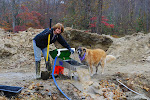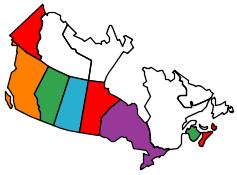And so it came to be, that exactly two days after we had moved everything in to the house and had it just the way we wanted it, category 5 Hurricane Mitch hit the Bay Islands of Honduras. These islands are not terribly flat, so a storm that comes and goes is not too much of a problem... the wind is broken by the mountains and vegetation, the waves are knocked down by the reef, and the water and rain roll into the sea just as fast as they can hit the ground. But Mitch had other ideas for his visit; he came, he hit, he stalled and for 5 days he battered the islands, remaining a "five" the whole time. The island of Guanaja, just 16 miles from our Roatan location played host to the eye wall of the storm. What was one of the most lush green islands you could ever see was totally brown when the storm moved away. Not a tree remained standing. Not a business was able to continue on. On the rest of the islands and even on the mainland, similar problems presented what was probably the worst thing we have ever had to deal with....
Thirty nine inches of rain fell in five days. The empty 50,000 gallon cistern on which we built our house filled in a weekend- not in a year like we had planned. Rivers that were normally 8 feet deep ran uncontrolled at a depth of 80 feet deep. Everyone and everything in their paths was destroyed. Tens of thousands of people on the mainland drowned or otherwise were killed by the storm. For months after the storm bodies were still washing up on the beeches of Roatan. I myself took it on the chin and came down with dengue fever (often referred to as Break-bone fever and resembling severe malaria). I also contracted a staph infection that caused me to lose 40 pounds in two weeks- and nearly took me out as well. They did for me what they could in my bed in our house- there were no flights to anywhere to make for a rescue. Even the two story airport in San Pedro Sula, where the hospital was located on the mainland was under water entirely. There was no landing strip. Not anywhere. The doctor from the barometric chamber and dive center, who Marilyn begged to come to the house, drove a nail into the wall above the bed and set me up with an IV drip. It was all anybody could do. Weeks later when I could get to a hospital, the dead bodies were still being "piled high" in the hall ways of just about every building that could be made into a temporary hospital.
That was the bad news. The good news was that we had planned for such a scenario as best we could. Planning matters. We did not build the house on the flat portion of our beachfront property where it would surely have been lost. We built it up on the hill. The normally tranquil seas in front of our property were transformed to 30 foot seas outside the reef and twelve foot waves inside the reef that hit the island beach. The 130 foot dock was gone like match sticks. The rugged stone wall crumbled and sank in the sand despite having solid footings. But the house? We had placed it high enough to stay out of the water. And we had built it to "take a 200 mile an hour wind." I have no way to tell you how hard the wind blew for those five days, but my guess would be 140 mph or so steadily and for a long time. Those 570 small panes of glass in louver lock-down- no problem. Roof shingles made of concrete- no problem- one and a half shingles on the very edge broke but the roof never even leaked. The concrete Hardi-siding plank siding of the house- no problem. So what for me at that time was a prison and a hospital....held. Nearby neighbors came and stayed in our fully concrete safe room downstairs and were also safe. As power was out for a long time we cooked everything in the frig and freezer for the neighborhood. We all made it. Our new house had earned our respect and that of those around us.
But once repairs were made, the dock rebuilt, the stonewall reconstructed, we began looking for ways to do more with the property. And while the property became more and more gorgeous with everything we did, there came a time when we though about putting it on the market. You don't just sell a place on an island in a foreign country overnight or because you decide you want to. That takes planning as well. And it became apparent early on that if it were going to sell handily, it would have to be a money making property. So that became our next mission and we built two casitas (little houses) and a giant pool and spa between them roughly in the shape of an angel fish. We used the casitas as guest houses for visiting friends and family, and ultimately turned them into an upscale B&B which did extremely well right from the get-go and right up until the day that we finally did sell the property.
Because we were located on the beautiful water of the bay of Honduras, but also wanted to market the lush botanical gardens that we created as the setting for the B&B and our own home, we named the place "Sea of Green." We had a mermaid sculpture carved which graced the property and became our advertising logo. It was part of the sculpture collection we gathered while on the island. We bought some pieces, were given some pieces and I carved a few of them myself. A look at more of these features as this story continues. But for this post I wanted to show the building of the casitas and the pool.....
...in the first shot below, a tarantula gets some TLC and exercise on Marilyn's hand- honest. Carlos, our head mason, looking on, taught her how to safely handle the normally scary critters. We almost never saw the tarantulas during the daytime unless we were disturbing the ground like we were when we were constructing all this, but at night they were everywhere by the thousands. Never had a problem with them even once.













No comments:
Post a Comment